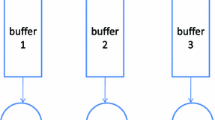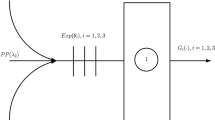Abstract
The subject of the present research is the M/M/n + G queue. This queue is characterized by Poisson arrivals at rate λ, exponential service times at rate μ, n service agents and generally distributed patience times of customers. The model is applied in the call center environment, as it captures the tradeoff between operational efficiency (staffing cost) and service quality (accessibility of agents).
In our research, three asymptotic operational regimes for medium to large call centers are studied. These regimes correspond to the following three staffing rules, as λ and n increase indefinitely and μ held fixed:
-
Efficiency-Driven (ED): \(n\ \approx \ (\lambda / \mu)\cdot (1 - \gamma),\gamma > 0,\)
-
Quality-Driven (QD): \(n \ \approx \ ( \lambda / \mu)\cdot (1 + \gamma),\gamma > 0\), and
-
Quality and Efficiency Driven (QED): \( n \ \approx \ \lambda/ \mu+\beta \sqrt{\lambda/\mu},-\infty < \beta < \infty \).
In the ED regime, the probability to abandon and average wait converge to constants. In the QD regime, we observe a very high service level at the cost of possible overstaffing. Finally, the QED regime carefully balances quality and efficiency: agents are highly utilized, but the probability to abandon and the average wait are small (converge to zero at rate 1/\(\sqrt{n}\)).
Numerical experiments demonstrate that, for a wide set of system parameters, the QED formulae provide excellent approximation for exact M/M/n + G performance measures. The much simpler ED approximations are still very useful for overloaded queueing systems.
Finally, empirical findings have demonstrated a robust linear relation between the fraction abandoning and average wait. We validate this relation, asymptotically, in the QED and QD regimes.
Similar content being viewed by others
References
M. Armony, I. Gurvich and A. Mandelbaum, Staffing and control of large-scale service systems with multiple customer classes and fully flexible servers, Working paper (2004). Available at http://iew3.technion.ac.il/serveng/References/references.html.
M. Armony and A. Mandelbaum, Design, staffing and control of large service systems: The case of a single customer class and multiple server types, Working paper (2004). Available at http://iew3.technion.ac.il/serveng/References/references.html.
F. Baccelli and G. Hebuterne, On queues with impatient customers, in: Kylstra F.J. (ed.), Performance '81., North-Holland Publishing Company, 1981) pp. 159–179.
P. Bain and P. Taylor, Consolidation, “Cowboys” and the developing employment relationship in British, Dutch and US call centres, in: Re-Organising Service Work., eds., U. Holtgrewe, C. Kerst and K. Shire (Ashgate Publishing Limited, 2002) pp. 42–62.
A. Bassamboo, J.M. Harrison and A. Zeevi, Design and control of a large call center: asymptotic analysis of an LP-based method (2004) Submitted for publication.
S. Borst, A. Mandelbaum and M. Reiman, Dimensioning large call centers, {Operations Research} 52(1) (2004) 17–34.
O.J. Boxma and P.R. de Waal, Multiserver queues with impatient customers, {ITC} 14 (1994) 743–756.
A. Brandt and M. Brandt, On the M.(n.)/M.(n.)/s. queue with impatient calls, {Performance Evaluation} 35 (1999) 1–18.
A. Brandt and M. Brandt, Asymptotic results and a Markovian approximation for the M.(n.)/M.(n.)/s.+GI. system, {Queueing Systems, Theory and Applications (QUESTA)} 41 (2002) 73–94.
L.D. Brown, N. Gans, A. Mandelbaum, A. Sakov, H. Shen, S. Zeltyn and L. Zhao, Statistical analysis of a telephone call center: a queueing science perspective, {Journal of the American Statistical Association (JASA)} 100(469) (2005) 36–50.
D.R. Cox and D. Oakes, Analysis of Survival Data. (Chapman and Hall, 1984).
D.J. Daley and L.D. Servi, Estimating customer loss rates from transactional data, in: International Series in Operations Research and Management Science., eds., J.G. Shanthikumar, and U. Sumita, (2000) pp. 313–332.
Datamonitor. http://www.datamonitor.com.
N.G. de Bruijn, Asymptotic Methods in Analysis. (Dover, 1981).
A.K. Erlang, On the rational determination of the number of circuits, in: The Life and Works of A.K. Erlang. eds., E. Brockmeyer, H.L. Halstrom, and A. Jensen (The Copenhagen Telephone Company, Copenhagen, 1948).
Z. Feldman, A. Mandelbaum, W. Massey and W. Whitt, Staffing of time-varying queues to achieve time-stable performance. Submitted to Management Science. (2004). Available at http://iew3.technion.ac.il/serveng/References/references.html.
N. Gans, G. Koole and A. Mandelbaum, Telephone call centers: a tutorial and literature review. Invited review paper, {Manufacturing and Service Operations Management} 5(2) (2003) 79–141.
O. Garnett, A. Mandelbaum and M. Reiman, Designing a telephone call-center with impatient customers, {Manufacturing and Service Operations Management} 4 (2002) 208–227.
B.W. Gnedenko and I.N. Kovalenko, Introduction to Queueing Theory. (Jerusalem, Israel) (1968). Program for Scientific Translations.
I. Gurvich, Design and control of the M/M/N queue with multi-class customers and many servers, M.Sc. Thesis, Technion (2004). Available at http://iew3.technion.ac.il/serveng/References/references.html.
S. Halfin and W. Whitt, Heavy-traffic limits for queues with many exponential servers, {Operations Research} 29 (1981) 567–588.
J.M. Harrison and A. Zeevi, (2004) A method for staffing large call centers using stochastic fluid models, {Manufacturing & Service Operations Management} (to appear in).
R.B. Haugen and E. Skogan, Queueing systems with stochastic time out. {IEEE Trans. Commun.} COM-28, (1980) 1984–1989.
D.L. Jagerman, Some properties of the Erlang loss function, {Bell Systems Technical Journal} 53 (1974) 525–551.
P. Jelenković, A. Mandelbaum and P. Momčilović, Heavy traffic limits for queues with many deterministic servers, {Queueing Systems: Theory and Applications (QUESTA)} 47 (2004) 53–69.
O.M. Jurkevic, On many-server systems with stochastic bounds for the waiting time (in Russian), {Izv. Akad. Nauk SSSR Techniceskaja kibernetika} 4 (1971) 39–46.
B.W. Kort, Models and methods for evaluating customer acceptance of telephone connections. GLOBECOM '83., IEEE (1983) 706–714.
A. Mandelbaum and N. Shimkin, A model for rational abandonment from invisible queues, {Queueing Systems: Theory and Applications (QUESTA)} 36 (2000) 141–173.
A. Mandelbaum and R. Schwartz, Simulation experiments with M/G/100 queues in the Halfin-Whitt (QED) regime. Technical Report, Technion (2002). Available at http://iew3.technion.ac.il/serveng/References/references.html.
A. Mandelbaum and S. Zeltyn, The Palm/Erlang-A queue, with applications to call centers. Teaching note to Service Engineering. course (2004). Available at http://iew3.technion.ac.il/serveng/References/references.html.
A. Mandelbaum and S. Zeltyn, The M/M/n. + G queue: summary of performance measures. Teaching note to Service Engineering. course. Available at http://iew3.technion.ac.il/serveng/References/references.html(2004).
A. Mandelbaum and S. Zeltyn, The impact of customers' patience on delay and abandonment: some empirically-driven experiments with the M/M/n. + G queue, {OR Spectrum} 26(3) (2004) 377–411. Special Issue on Call Centers.
A. Mandelbaum and S. Zeltyn, Service engineering in action: the Palm/Erlang-A queue, with applications to call centers. Invited chapter to {IAO} book project. Available at http://iew3.technion.ac.il/serveng/References/references.html.
A. Mandelbaum and S. Zeltyn, Dimensioning M/M/n. + G queue, Working paper (2005).
A.W. Massey and B.R. Wallace, An optimal design of the M/M/C/K queue for call centers, to appear in {Queueing Systems} (2004).
C. Palm, Methods of judging the annoyance caused by congestion, {Tele} 4 (1953) 189–208.
C. Palm, Research on telephone traffic carried by full availability groups. Tele 1, 107 pp. (English translation of results first published in 1946 in Swedish in the same journal, which was then entitled {Tekniska Meddelanden fran Kungl. (1957) Telegrafstyrelsen}.)
J.W. Roberts, Recent observations of subscriber behavior, in: Proceedings of the 9th International Tele-traffic Conference. (1979).
N. Shimkin and A. Mandelbaum, Rational abandonment from tele-queues: non-linear waiting costs with heterogeneous preferences, {Queueing Systems: Theory and Applications (QUESTA)} 47 (2004) 117–146.
U.S. Bureau of Labor Statistics. Table B-1: Employees on Nonfarm Payrolls by Major Industry, 1950 to Date. As reported on www.bls.gov.
A.R. Ward and P.W. Glynn, A diffusion approximation for a Markovian queue with reneging, {Queueing Systems: Theory and Applications (QUESTA)} 43 (2003) 103–128.
A.R. Ward and P.W. Glynn, A diffusion approximation for a GI/GI/1 queue with balking or reneging. Draft (2005).
W. Whitt, Fluid models for many-server queues with abandonments, {Operations Research} (to appear) (2004).
W. Whitt, Sensitivity of performance in the Erlang A model to changes in the model parameters, Submitted to {Operations Research} (2004).
W. Whitt, Staffing a call center with uncertain arrival rate and absenteeism. Submitted to {Management Science} (2004).
W. Whitt, Engineering solution of a basic call-center model, {Management Science} 51(2) (2005) 221–235.
W. Whitt, Two fluid approximations for multi-server queues with abandonments, {Operations Research Letters} 33 (2005) 363–372.
S. Zeltyn and A. Mandelbaum, Call centers with impatient customers: many-server asymptotics of the M/M/n. + G queue (2005). Internet Supplement. Available at http://iew3.technion.ac.il/serveng/References/references.html.
E. Zohar, A. Mandelbaum and N. Shimkin, Adaptive behavior of impatient customers in tele-queues: theory and empirical support, {Management Science} 48 (2002) 566–583.
Author information
Authors and Affiliations
Corresponding author
Additional information
AMS subject classification: 60K25, 68M20, 90B22
An Internet Supplement to the present paper is downloadable from http://iew3.technion.ac.il/serveng/References/references.html.
Rights and permissions
About this article
Cite this article
Zeltyn, S., Mandelbaum, A. Call Centers with Impatient Customers: Many-Server Asymptotics of the M/M/n + G Queue. Queueing Syst 51, 361–402 (2005). https://doi.org/10.1007/s11134-005-3699-8
Received:
Revised:
Issue Date:
DOI: https://doi.org/10.1007/s11134-005-3699-8




